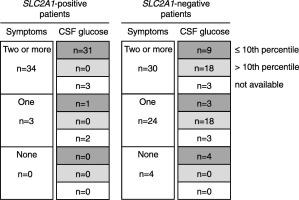当前位置:
X-MOL 学术
›
J. Neurol. Sci.
›
论文详情
Our official English website, www.x-mol.net, welcomes your feedback! (Note: you will need to create a separate account there.)
The role of molecular analysis of SLC2A1 in the diagnostic workup of glucose transporter 1 deficiency syndrome
Journal of the Neurological Sciences ( IF 4.4 ) Pub Date : 2020-09-01 , DOI: 10.1016/j.jns.2020.117041 Satoru Takahashi 1 , Ryosuke Tanaka 1 , Ryo Takeguchi 1 , Mami Kuroda 1 , Yuichi Akaba 1 , Yasushi Ito 2
Journal of the Neurological Sciences ( IF 4.4 ) Pub Date : 2020-09-01 , DOI: 10.1016/j.jns.2020.117041 Satoru Takahashi 1 , Ryosuke Tanaka 1 , Ryo Takeguchi 1 , Mami Kuroda 1 , Yuichi Akaba 1 , Yasushi Ito 2
Affiliation

|
The study aimed to investigate the role of molecular analysis of SLC2A1 in the diagnostic workup of glucose transporter 1 deficiency syndrome (Glut1DS). During 2006-2020, we received 100 requests for SLC2A1 variant analysis of patients clinically suspected for Glut1DS. Pathogenic variants were detected in 37 patients, among whom 11 were familial cases. Most patients presented with epilepsy (n = 31; 84%), movement disorders (MD) (n = 28; 76%), and intellectual disabilities (ID) (n = 29; 78%). Moreover, paroxysmal dyskinesias (PD) (n = 10; 27%) were more frequently seen in familial cases (55%) than in sporadic cases (15%) (p < .05). The Glut1DS patients with ID typically had either epilepsy or MD. The presence of MD, particularly when associated with epilepsy or ID, indicated Glut1DS (p < .05). The cerebrospinal fluid (CSF) glucose levels were at or below the 10th percentile in all 32 SLC2A1-positive patients but only in 16 of 52 (31%) SLC2A1-negative patients (p < .05). Thus, CSF analysis is an essential tool in the diagnostic workup of Glut1DS. SLC2A1 molecular analysis should be performed in patients with a family history of Glut1DS or with at least one of the following clinical features, such as epilepsy, MD, and PD with or without ID, and low CSF glucose level. This would help in precise molecular diagnosis of the disease and facilitate effective treatment and appropriate genetic counseling.
中文翻译:

SLC2A1分子分析在葡萄糖转运蛋白1缺乏综合征诊断检查中的作用
本研究旨在探讨 SLC2A1 的分子分析在葡萄糖转运蛋白 1 缺乏综合征 (Glut1DS) 诊断检查中的作用。在 2006-2020 年间,我们收到了 100 份对临床疑似 Glut1DS 患者进行 SLC2A1 变异分析的请求。在 37 例患者中检测到致病变异,其中 11 例为家族性病例。大多数患者出现癫痫 (n = 31; 84%)、运动障碍 (MD) (n = 28; 76%) 和智力障碍 (ID) (n = 29; 78%)。此外,阵发性运动障碍 (PD) (n = 10; 27%) 在家族病例 (55%) 中比在散发病例 (15%) 中更常见 (p < .05)。ID 的 Glut1DS 患者通常患有癫痫或 MD。MD 的存在,特别是与癫痫或 ID 相关时,表明 Glut1DS (p < .05)。在所有 32 名 SLC2A1 阳性患者中,脑脊液 (CSF) 葡萄糖水平处于或低于第 10 个百分位,但仅在 52 名 SLC2A1 阴性患者中的 16 名 (31%) (p < .05)。因此,CSF 分析是 Glut1DS 诊断检查的重要工具。有 Glut1DS 家族史或至少有以下临床特征之一的患者应进行 SLC2A1 分子分析,如癫痫、MD 和 PD 伴或不伴 ID,以及低 CSF 葡萄糖水平。这将有助于对疾病进行精确的分子诊断,并促进有效的治疗和适当的遗传咨询。有 Glut1DS 家族史或至少有以下临床特征之一的患者应进行 SLC2A1 分子分析,如癫痫、MD 和 PD 伴或不伴 ID,以及低 CSF 葡萄糖水平。这将有助于对疾病进行精确的分子诊断,并促进有效的治疗和适当的遗传咨询。有 Glut1DS 家族史或至少有以下临床特征之一的患者应进行 SLC2A1 分子分析,如癫痫、MD 和 PD 伴或不伴 ID,以及低 CSF 葡萄糖水平。这将有助于对疾病进行精确的分子诊断,并促进有效的治疗和适当的遗传咨询。
更新日期:2020-09-01
中文翻译:

SLC2A1分子分析在葡萄糖转运蛋白1缺乏综合征诊断检查中的作用
本研究旨在探讨 SLC2A1 的分子分析在葡萄糖转运蛋白 1 缺乏综合征 (Glut1DS) 诊断检查中的作用。在 2006-2020 年间,我们收到了 100 份对临床疑似 Glut1DS 患者进行 SLC2A1 变异分析的请求。在 37 例患者中检测到致病变异,其中 11 例为家族性病例。大多数患者出现癫痫 (n = 31; 84%)、运动障碍 (MD) (n = 28; 76%) 和智力障碍 (ID) (n = 29; 78%)。此外,阵发性运动障碍 (PD) (n = 10; 27%) 在家族病例 (55%) 中比在散发病例 (15%) 中更常见 (p < .05)。ID 的 Glut1DS 患者通常患有癫痫或 MD。MD 的存在,特别是与癫痫或 ID 相关时,表明 Glut1DS (p < .05)。在所有 32 名 SLC2A1 阳性患者中,脑脊液 (CSF) 葡萄糖水平处于或低于第 10 个百分位,但仅在 52 名 SLC2A1 阴性患者中的 16 名 (31%) (p < .05)。因此,CSF 分析是 Glut1DS 诊断检查的重要工具。有 Glut1DS 家族史或至少有以下临床特征之一的患者应进行 SLC2A1 分子分析,如癫痫、MD 和 PD 伴或不伴 ID,以及低 CSF 葡萄糖水平。这将有助于对疾病进行精确的分子诊断,并促进有效的治疗和适当的遗传咨询。有 Glut1DS 家族史或至少有以下临床特征之一的患者应进行 SLC2A1 分子分析,如癫痫、MD 和 PD 伴或不伴 ID,以及低 CSF 葡萄糖水平。这将有助于对疾病进行精确的分子诊断,并促进有效的治疗和适当的遗传咨询。有 Glut1DS 家族史或至少有以下临床特征之一的患者应进行 SLC2A1 分子分析,如癫痫、MD 和 PD 伴或不伴 ID,以及低 CSF 葡萄糖水平。这将有助于对疾病进行精确的分子诊断,并促进有效的治疗和适当的遗传咨询。



























 京公网安备 11010802027423号
京公网安备 11010802027423号